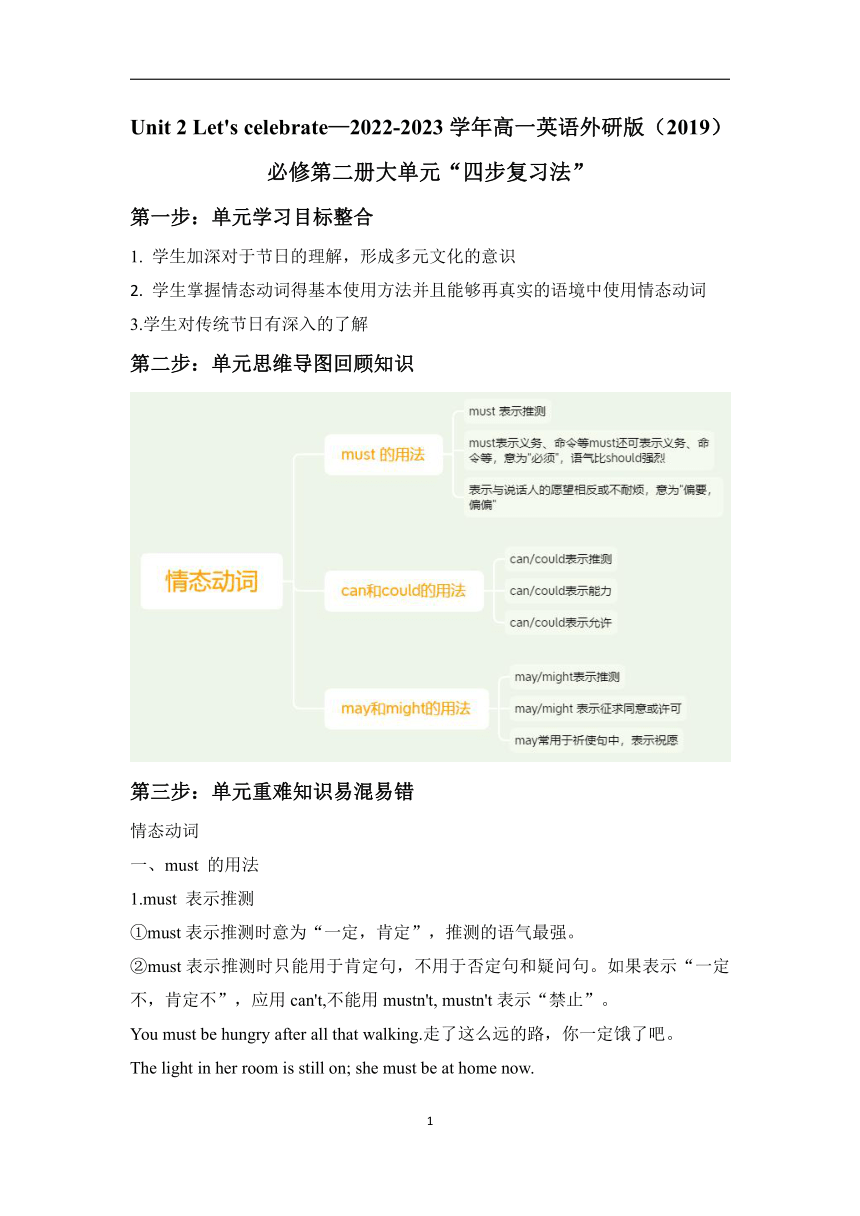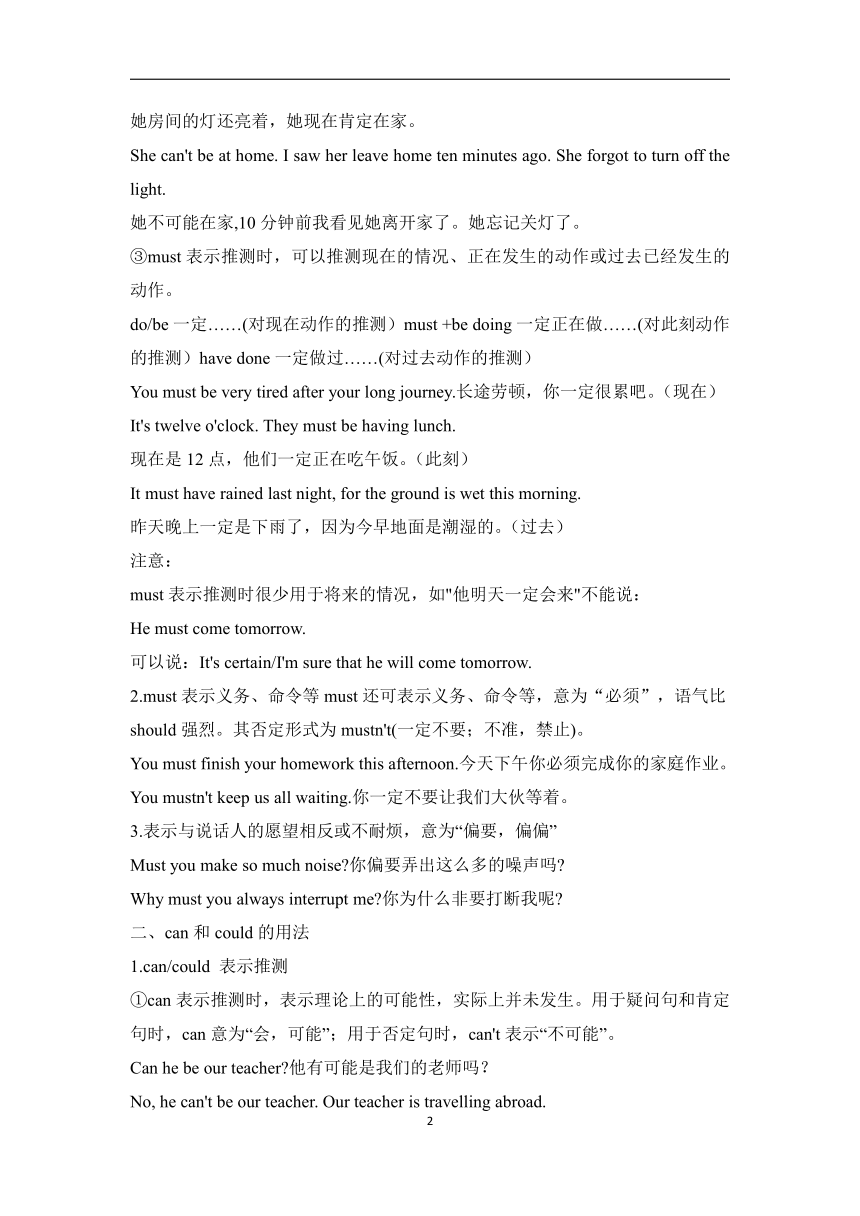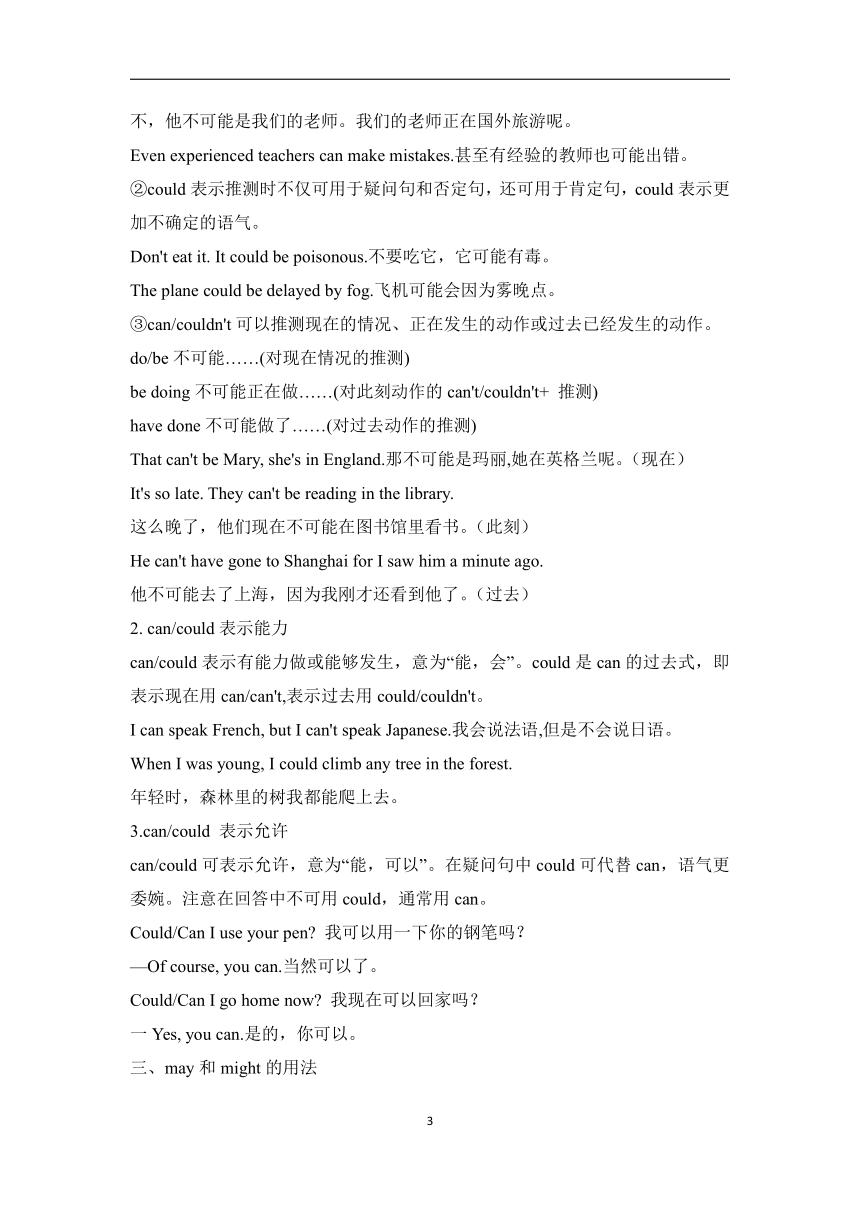外研版(2019)必修 第二册Unit 2 Let's celebrate!大单元“四步复习法”学案(含答案)
文档属性
| 名称 | 外研版(2019)必修 第二册Unit 2 Let's celebrate!大单元“四步复习法”学案(含答案) |  | |
| 格式 | docx | ||
| 文件大小 | 70.8KB | ||
| 资源类型 | 教案 | ||
| 版本资源 | 外研版(2019) | ||
| 科目 | 英语 | ||
| 更新时间 | 2022-12-09 21:05:20 | ||
图片预览



文档简介
Unit 2 Let's celebrate—2022-2023学年高一英语外研版(2019)必修第二册大单元“四步复习法”
第一步:单元学习目标整合
1. 学生加深对于节日的理解,形成多元文化的意识
2. 学生掌握情态动词得基本使用方法并且能够再真实的语境中使用情态动词
3.学生对传统节日有深入的了解
第二步:单元思维导图回顾知识
第三步:单元重难知识易混易错
情态动词
一、must 的用法
1.must 表示推测
①must表示推测时意为“一定,肯定”,推测的语气最强。
②must表示推测时只能用于肯定句,不用于否定句和疑问句。如果表示“一定不,肯定不”,应用can't,不能用mustn't, mustn't表示“禁止”。
You must be hungry after all that walking.走了这么远的路,你一定饿了吧。
The light in her room is still on; she must be at home now.
她房间的灯还亮着,她现在肯定在家。
She can't be at home. I saw her leave home ten minutes ago. She forgot to turn off the light.
她不可能在家,10分钟前我看见她离开家了。她忘记关灯了。
③must表示推测时,可以推测现在的情况、正在发生的动作或过去已经发生的动作。
do/be一定……(对现在动作的推测)must +be doing一定正在做……(对此刻动作的推测)have done一定做过……(对过去动作的推测)
You must be very tired after your long journey.长途劳顿,你一定很累吧。(现在)
It's twelve o'clock. They must be having lunch.
现在是12点,他们一定正在吃午饭。(此刻)
It must have rained last night, for the ground is wet this morning.
昨天晚上一定是下雨了,因为今早地面是潮湿的。(过去)
注意:
must表示推测时很少用于将来的情况,如"他明天一定会来"不能说:
He must come tomorrow.
可以说:It's certain/I'm sure that he will come tomorrow.
2.must表示义务、命令等must还可表示义务、命令等,意为“必须”,语气比should强烈。其否定形式为mustn't(一定不要;不准,禁止)。
You must finish your homework this afternoon.今天下午你必须完成你的家庭作业。
You mustn't keep us all waiting.你一定不要让我们大伙等着。
3.表示与说话人的愿望相反或不耐烦,意为“偏要,偏偏”
Must you make so much noise 你偏要弄出这么多的噪声吗
Why must you always interrupt me 你为什么非要打断我呢
二、can和could的用法
1.can/could 表示推测
①can表示推测时,表示理论上的可能性,实际上并未发生。用于疑问句和肯定句时,can意为“会,可能”;用于否定句时,can't表示“不可能”。
Can he be our teacher 他有可能是我们的老师吗?
No, he can't be our teacher. Our teacher is travelling abroad.
不,他不可能是我们的老师。我们的老师正在国外旅游呢。
Even experienced teachers can make mistakes.甚至有经验的教师也可能出错。
②could表示推测时不仅可用于疑问句和否定句,还可用于肯定句,could表示更加不确定的语气。
Don't eat it. It could be poisonous.不要吃它,它可能有毒。
The plane could be delayed by fog.飞机可能会因为雾晚点。
③can/couldn't可以推测现在的情况、正在发生的动作或过去已经发生的动作。
do/be不可能……(对现在情况的推测)
be doing不可能正在做……(对此刻动作的can't/couldn't+ 推测)
have done不可能做了……(对过去动作的推测)
That can't be Mary, she's in England.那不可能是玛丽,她在英格兰呢。(现在)
It's so late. They can't be reading in the library.
这么晚了,他们现在不可能在图书馆里看书。(此刻)
He can't have gone to Shanghai for I saw him a minute ago.
他不可能去了上海,因为我刚才还看到他了。(过去)
2. can/could表示能力
can/could表示有能力做或能够发生,意为“能,会”。could是can的过去式,即表示现在用can/can't,表示过去用could/couldn't。
I can speak French, but I can't speak Japanese.我会说法语,但是不会说日语。
When I was young, I could climb any tree in the forest.
年轻时,森林里的树我都能爬上去。
3.can/could 表示允许
can/could可表示允许,意为“能,可以”。在疑问句中could可代替can,语气更委婉。注意在回答中不可用could,通常用can。
Could/Can I use your pen 我可以用一下你的钢笔吗?
—Of course, you can.当然可以了。
Could/Can I go home now 我现在可以回家吗?
一Yes, you can.是的,你可以。
三、may和might的用法
1.may/might表示推测
①may/might表示把握不大的推测,用于肯定句和否定句,不能用于疑问句。
might不表示过去时态,只是语气上比 may更委婉,表示的可能性更小。
He may be very busy these days.他这些日子可能很忙。
Are you coming to Mary's birthday party 你会来参加玛丽的生日聚会吗?
I'm not sure. I might go to the concert instead.我不确定,相反我可能去听音乐会。
②may/might 可以推测现在的情况、正在发生的动作、过去已经发生的动作以及将来的情况。do/be可能……(对现在情况的推测)
be doing 可能正在做……(对此刻动作的推测)
may/might +have done 可能做过……(对过去动作的推测)(do/be 可能会……(对将来情况的推测)
Today is Sunday. She may not be in the office.
今天是周日。她可能不在办公室。(现在)
They might be holding a meeting in the classroom.
他们或许正在教室开会。(此刻)
2.may/might 表示征求同意或许可
may/might可表示征求同意或许可(在疑问句中表示“征求同意”,在陈述句中表示“许可”),意为“可以”。表示征求同意时,might 比may的语气更委婉。一般疑问句的肯定回答用may/can,但作出否定回答时要用can't/mustn't,表示“不可以,禁止”。
You may keep the book for two weeks.这本书你可以借两个星期。
May I watch TV after supper 晚饭后我可以看电视吗
Yes, you may/can.是的,你可以。
No, you mustn't/can't.不,你不能。
3.may常用于祈使句中,表示祝愿
May you succeed!(=Wish you success!)祝你成功!
May your dream come true! 愿你梦想成真!
练习:选词填空
can could may might must
1. Helen ______ go on a trip with us, but she isn't quite sure.
2. My sister met him at the theatre last night, so he ______ have attended your lecture.
3. I am sure I saw Brian in the park this morning.
You______ be imagining things. He left for America last night.
4. Is John coming by bus He should, but he_______. He likes riding his bike.
5. Isn't that your teacher over there No, it______ be him. I'm sure he doesn't wear glasses.
6. I saw him just now, so he ______ have gone abroad.
7. Don't worry about me. I ______ take care of myself.
8. What has happened to George He hasn't turned up so far. I don't know. He _______ have got lost in the woods.
9. She looks very happy. She ______ have passed the exam. I guess so. It's not difficult after all.
10. For example, you______ want to be a pilot but _______ become one you because your eyesight is not good enough.
答案:1.may/might 2.can’t/couldn’t 3.must 4.may not/might not 5.can’t/couldn’t 6.can’t/couldn’t 7.can 8.may/might 9.must 10.may/might; can’t
第四步:单元核心素养对接高考
语法填空
To understand a painting, we're taught to look for color, composition, and light. But how can a painting ①_____(appreciate) by someone who's blind Through touch, the one thing gallery signs tell you not ②_____(do). John Olson, a former ③_____(photograph) and his team turn paintings into fully textured 3D models.
The tactile(可触知的) paintings work as a way to show art to ④_____ blind because we don't see with just Our eyes: We see with our brains. Research in the field of neuroplasticity—the brain's adaptability—shows that the visual cortex(大脑皮层) is made active by touch. Blind people recognize shapes with their ⑤_____ exist senses, in a way similar to that of ⑥_____(sight) people, says Ella Striem-Amit, a Harvard scientist.
Luc Gandarias, who's now thirteen, went blind suddenly ⑦_____ age seven. When he felt a 3D version of Leonardo da Vinci's "Mona Lisa" he ⑧_____(notice) her smile right away. "I can actually feel what you see when you look at it," he said.
For Luc, this means ⑨_____(independent). "The feeling of being able to see it ⑩_____ to form my opinion is like breaking down another wall as a blind person."
答案:①be appreciated ②to do ③photographer ④the ⑤existing ⑥sighted ⑦at⑧noticed ⑨independence ⑩and
解析:①考查含有情态动词的被动语态。句意:但是一个盲人怎么能欣赏一幅画呢 主语a painting与谓语appreciate为被动关系,且置于情态动词can之后,所以本句为含有情态动词的被动语态。故填be appreciated。
②考查不定式。句意:通过触摸,这是画廊招牌告诉你不要做的一件事。tell sb not to do sth“告诉某人不要做某事”为固定短语。故填to do。
③考查名词。句意:约翰·奥尔森是一位前摄影师,他和他的团队将绘画转化为全纹理3D模型。单数名词做主语,根据句意表示“摄影师”,此处为单数概念,故填photographer。
④考查冠词。句意:触觉画是向盲人展示艺术的一种方式,因为我们不仅仅用眼睛看;我们用大脑看。the blind“盲人”,the+形容词表示一类人。故填the。
⑤考查形容词。句意:哈佛大学的科学家埃拉·斯特里姆-阿米特(Ella Striem-Amit)说,盲人用他们现有的感官识别形状,在某种程度上与正常人相似。形容词existing作定语,修饰sense。故填existing。
⑥考查形容词。句意:哈佛大学的科学家埃拉·斯特里姆-阿米特(Ella Striem-Amit)说,盲人用他们现有的感官识别形状,在某种程度上与正常人相似。形容词sighted作定语修饰名词people,表示“能看见的、不盲的”。故填sighted。
⑦考查介词。句意:Luc Gandarias今年13岁,7岁时突然失明。表示在多大年龄时,用介词at。故填at。
⑧考查时态。句意:当他触摸到莱昂纳多达·芬奇的3D版《蒙娜丽莎》时,他立刻注意到了她的微笑。根据“he felt”可知,本句为一般过去时。故填noticed。
⑨考查名词。句意:对卢克来说,这意味着独立。不可数名词independence作mean的宾语。故填independence。
⑩考查连词。句意:能够看到它并形成我的观点的感觉就像盲人推倒了另一堵墙。根据句意可知,前后为并列关系,所以用and来连接。故填and。
2
第一步:单元学习目标整合
1. 学生加深对于节日的理解,形成多元文化的意识
2. 学生掌握情态动词得基本使用方法并且能够再真实的语境中使用情态动词
3.学生对传统节日有深入的了解
第二步:单元思维导图回顾知识
第三步:单元重难知识易混易错
情态动词
一、must 的用法
1.must 表示推测
①must表示推测时意为“一定,肯定”,推测的语气最强。
②must表示推测时只能用于肯定句,不用于否定句和疑问句。如果表示“一定不,肯定不”,应用can't,不能用mustn't, mustn't表示“禁止”。
You must be hungry after all that walking.走了这么远的路,你一定饿了吧。
The light in her room is still on; she must be at home now.
她房间的灯还亮着,她现在肯定在家。
She can't be at home. I saw her leave home ten minutes ago. She forgot to turn off the light.
她不可能在家,10分钟前我看见她离开家了。她忘记关灯了。
③must表示推测时,可以推测现在的情况、正在发生的动作或过去已经发生的动作。
do/be一定……(对现在动作的推测)must +be doing一定正在做……(对此刻动作的推测)have done一定做过……(对过去动作的推测)
You must be very tired after your long journey.长途劳顿,你一定很累吧。(现在)
It's twelve o'clock. They must be having lunch.
现在是12点,他们一定正在吃午饭。(此刻)
It must have rained last night, for the ground is wet this morning.
昨天晚上一定是下雨了,因为今早地面是潮湿的。(过去)
注意:
must表示推测时很少用于将来的情况,如"他明天一定会来"不能说:
He must come tomorrow.
可以说:It's certain/I'm sure that he will come tomorrow.
2.must表示义务、命令等must还可表示义务、命令等,意为“必须”,语气比should强烈。其否定形式为mustn't(一定不要;不准,禁止)。
You must finish your homework this afternoon.今天下午你必须完成你的家庭作业。
You mustn't keep us all waiting.你一定不要让我们大伙等着。
3.表示与说话人的愿望相反或不耐烦,意为“偏要,偏偏”
Must you make so much noise 你偏要弄出这么多的噪声吗
Why must you always interrupt me 你为什么非要打断我呢
二、can和could的用法
1.can/could 表示推测
①can表示推测时,表示理论上的可能性,实际上并未发生。用于疑问句和肯定句时,can意为“会,可能”;用于否定句时,can't表示“不可能”。
Can he be our teacher 他有可能是我们的老师吗?
No, he can't be our teacher. Our teacher is travelling abroad.
不,他不可能是我们的老师。我们的老师正在国外旅游呢。
Even experienced teachers can make mistakes.甚至有经验的教师也可能出错。
②could表示推测时不仅可用于疑问句和否定句,还可用于肯定句,could表示更加不确定的语气。
Don't eat it. It could be poisonous.不要吃它,它可能有毒。
The plane could be delayed by fog.飞机可能会因为雾晚点。
③can/couldn't可以推测现在的情况、正在发生的动作或过去已经发生的动作。
do/be不可能……(对现在情况的推测)
be doing不可能正在做……(对此刻动作的can't/couldn't+ 推测)
have done不可能做了……(对过去动作的推测)
That can't be Mary, she's in England.那不可能是玛丽,她在英格兰呢。(现在)
It's so late. They can't be reading in the library.
这么晚了,他们现在不可能在图书馆里看书。(此刻)
He can't have gone to Shanghai for I saw him a minute ago.
他不可能去了上海,因为我刚才还看到他了。(过去)
2. can/could表示能力
can/could表示有能力做或能够发生,意为“能,会”。could是can的过去式,即表示现在用can/can't,表示过去用could/couldn't。
I can speak French, but I can't speak Japanese.我会说法语,但是不会说日语。
When I was young, I could climb any tree in the forest.
年轻时,森林里的树我都能爬上去。
3.can/could 表示允许
can/could可表示允许,意为“能,可以”。在疑问句中could可代替can,语气更委婉。注意在回答中不可用could,通常用can。
Could/Can I use your pen 我可以用一下你的钢笔吗?
—Of course, you can.当然可以了。
Could/Can I go home now 我现在可以回家吗?
一Yes, you can.是的,你可以。
三、may和might的用法
1.may/might表示推测
①may/might表示把握不大的推测,用于肯定句和否定句,不能用于疑问句。
might不表示过去时态,只是语气上比 may更委婉,表示的可能性更小。
He may be very busy these days.他这些日子可能很忙。
Are you coming to Mary's birthday party 你会来参加玛丽的生日聚会吗?
I'm not sure. I might go to the concert instead.我不确定,相反我可能去听音乐会。
②may/might 可以推测现在的情况、正在发生的动作、过去已经发生的动作以及将来的情况。do/be可能……(对现在情况的推测)
be doing 可能正在做……(对此刻动作的推测)
may/might +have done 可能做过……(对过去动作的推测)(do/be 可能会……(对将来情况的推测)
Today is Sunday. She may not be in the office.
今天是周日。她可能不在办公室。(现在)
They might be holding a meeting in the classroom.
他们或许正在教室开会。(此刻)
2.may/might 表示征求同意或许可
may/might可表示征求同意或许可(在疑问句中表示“征求同意”,在陈述句中表示“许可”),意为“可以”。表示征求同意时,might 比may的语气更委婉。一般疑问句的肯定回答用may/can,但作出否定回答时要用can't/mustn't,表示“不可以,禁止”。
You may keep the book for two weeks.这本书你可以借两个星期。
May I watch TV after supper 晚饭后我可以看电视吗
Yes, you may/can.是的,你可以。
No, you mustn't/can't.不,你不能。
3.may常用于祈使句中,表示祝愿
May you succeed!(=Wish you success!)祝你成功!
May your dream come true! 愿你梦想成真!
练习:选词填空
can could may might must
1. Helen ______ go on a trip with us, but she isn't quite sure.
2. My sister met him at the theatre last night, so he ______ have attended your lecture.
3. I am sure I saw Brian in the park this morning.
You______ be imagining things. He left for America last night.
4. Is John coming by bus He should, but he_______. He likes riding his bike.
5. Isn't that your teacher over there No, it______ be him. I'm sure he doesn't wear glasses.
6. I saw him just now, so he ______ have gone abroad.
7. Don't worry about me. I ______ take care of myself.
8. What has happened to George He hasn't turned up so far. I don't know. He _______ have got lost in the woods.
9. She looks very happy. She ______ have passed the exam. I guess so. It's not difficult after all.
10. For example, you______ want to be a pilot but _______ become one you because your eyesight is not good enough.
答案:1.may/might 2.can’t/couldn’t 3.must 4.may not/might not 5.can’t/couldn’t 6.can’t/couldn’t 7.can 8.may/might 9.must 10.may/might; can’t
第四步:单元核心素养对接高考
语法填空
To understand a painting, we're taught to look for color, composition, and light. But how can a painting ①_____(appreciate) by someone who's blind Through touch, the one thing gallery signs tell you not ②_____(do). John Olson, a former ③_____(photograph) and his team turn paintings into fully textured 3D models.
The tactile(可触知的) paintings work as a way to show art to ④_____ blind because we don't see with just Our eyes: We see with our brains. Research in the field of neuroplasticity—the brain's adaptability—shows that the visual cortex(大脑皮层) is made active by touch. Blind people recognize shapes with their ⑤_____ exist senses, in a way similar to that of ⑥_____(sight) people, says Ella Striem-Amit, a Harvard scientist.
Luc Gandarias, who's now thirteen, went blind suddenly ⑦_____ age seven. When he felt a 3D version of Leonardo da Vinci's "Mona Lisa" he ⑧_____(notice) her smile right away. "I can actually feel what you see when you look at it," he said.
For Luc, this means ⑨_____(independent). "The feeling of being able to see it ⑩_____ to form my opinion is like breaking down another wall as a blind person."
答案:①be appreciated ②to do ③photographer ④the ⑤existing ⑥sighted ⑦at⑧noticed ⑨independence ⑩and
解析:①考查含有情态动词的被动语态。句意:但是一个盲人怎么能欣赏一幅画呢 主语a painting与谓语appreciate为被动关系,且置于情态动词can之后,所以本句为含有情态动词的被动语态。故填be appreciated。
②考查不定式。句意:通过触摸,这是画廊招牌告诉你不要做的一件事。tell sb not to do sth“告诉某人不要做某事”为固定短语。故填to do。
③考查名词。句意:约翰·奥尔森是一位前摄影师,他和他的团队将绘画转化为全纹理3D模型。单数名词做主语,根据句意表示“摄影师”,此处为单数概念,故填photographer。
④考查冠词。句意:触觉画是向盲人展示艺术的一种方式,因为我们不仅仅用眼睛看;我们用大脑看。the blind“盲人”,the+形容词表示一类人。故填the。
⑤考查形容词。句意:哈佛大学的科学家埃拉·斯特里姆-阿米特(Ella Striem-Amit)说,盲人用他们现有的感官识别形状,在某种程度上与正常人相似。形容词existing作定语,修饰sense。故填existing。
⑥考查形容词。句意:哈佛大学的科学家埃拉·斯特里姆-阿米特(Ella Striem-Amit)说,盲人用他们现有的感官识别形状,在某种程度上与正常人相似。形容词sighted作定语修饰名词people,表示“能看见的、不盲的”。故填sighted。
⑦考查介词。句意:Luc Gandarias今年13岁,7岁时突然失明。表示在多大年龄时,用介词at。故填at。
⑧考查时态。句意:当他触摸到莱昂纳多达·芬奇的3D版《蒙娜丽莎》时,他立刻注意到了她的微笑。根据“he felt”可知,本句为一般过去时。故填noticed。
⑨考查名词。句意:对卢克来说,这意味着独立。不可数名词independence作mean的宾语。故填independence。
⑩考查连词。句意:能够看到它并形成我的观点的感觉就像盲人推倒了另一堵墙。根据句意可知,前后为并列关系,所以用and来连接。故填and。
2
